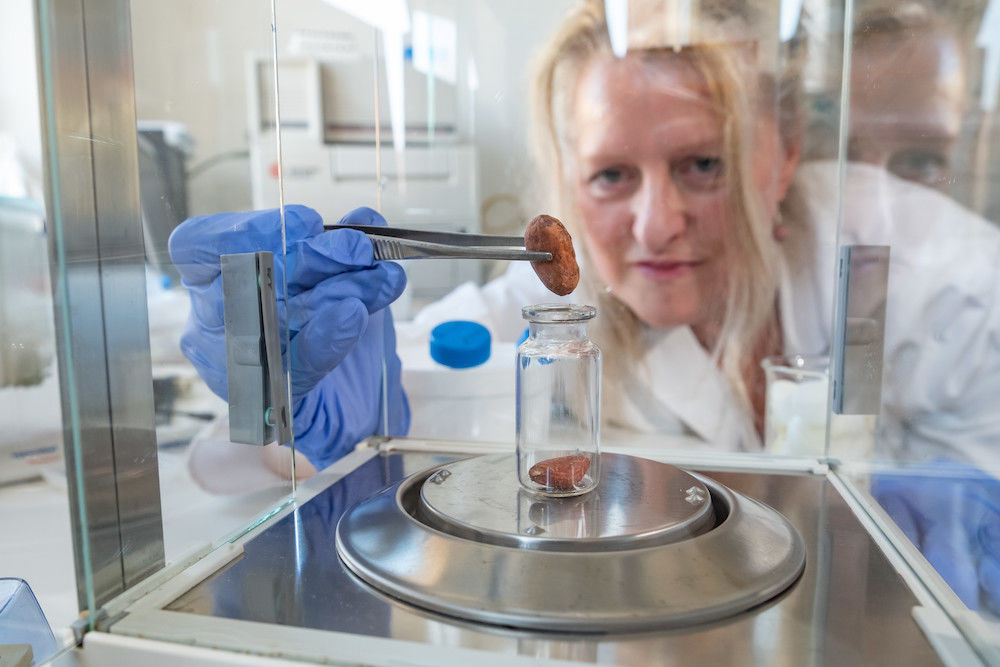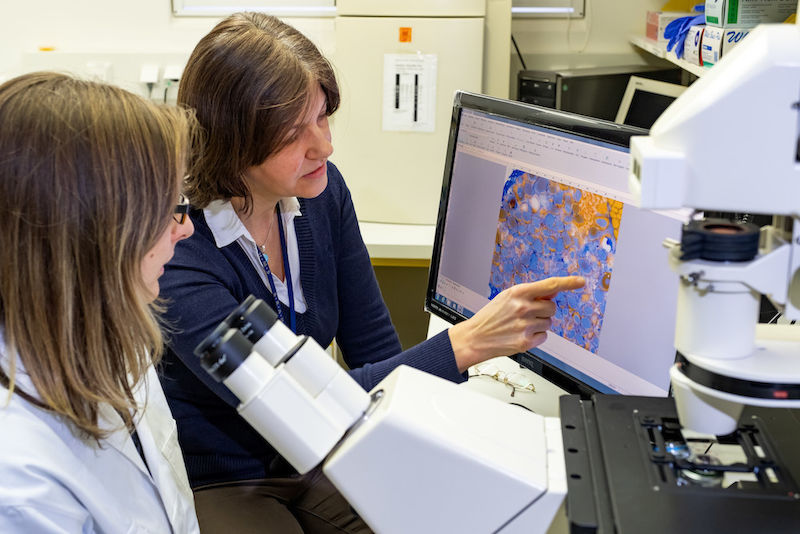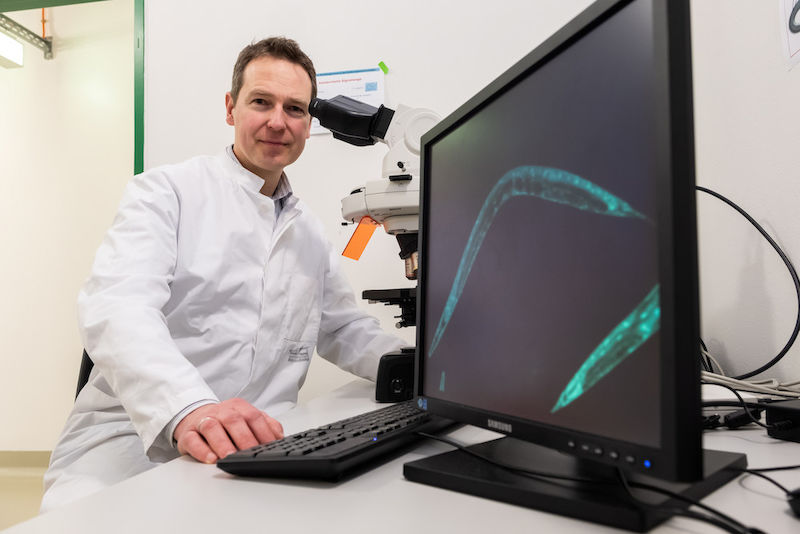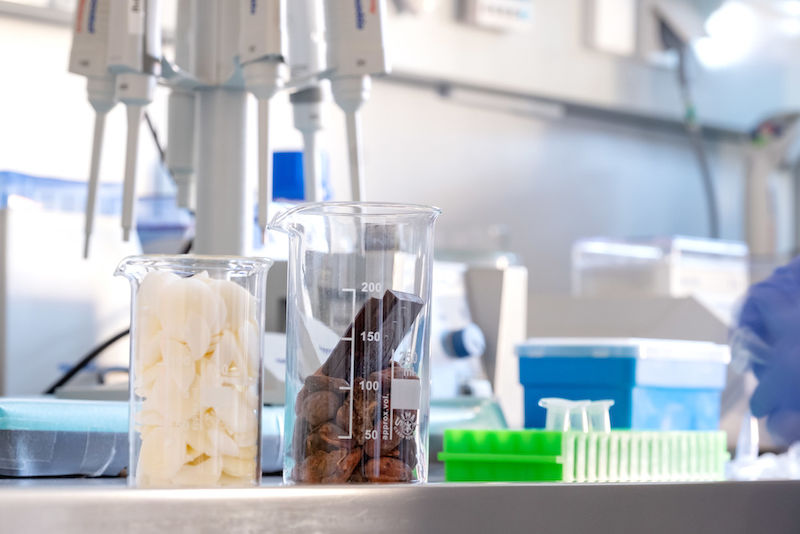Food of the future

Anyone who talks to Professor Gabriele Stangl about her work will always end up discussing vitamin D. The substance, which is so important for the human organism, is a theme throughout the research of the nutritionist from Halle. When she talks about her field of research in her office on the Weinberg Campus, it quickly becomes clear: “Nutrition research has become a major topic.” It is something Stangl is well aware of, as she has held a professorship for human nutrition at MLU since 2004.
When she came to Halle 14 years ago, nutrition sciences here were still in their infancy. The institute of the same name had only been christened a few years earlier. And although the degree programme, which was also launched in the winter semester of 2000/2001, immediately became a major success, the institute, initially equipped with only one professorship, was still leading a rather shadowy existence.
None of this can be felt today. Today the Institute for Agricultural and Nutritional Sciences – as it is now called – offers a much broader range of content and has thus also grown in terms of its personnel. At the same time, nutrition research at the MLU has long since become interdisciplinary. Doctors, chemists and biologists are just as involved as nutritionists. And research is often carried out within the framework of high-level research projects or even as part of comprehensive networks.
One of these competence cluster’s is “nutriCARD” which studies nutrition and cardiovascular health. Funded by the Federal Ministry of Education and Research (BMBF) since 2015, it has pooled together the scientific expertise of the three Central German universities of Halle, Jena and Leipzig in the field of nutrition. “Upwards of 40 scientists are investigating the mechanisms of nutrition-related diseases within the framework of nutriCARD. They are also looking for solutions to healthier foods,” explains Stangl. The research that is conducted in Halle mainly investigates the causal effects of food ingredients on metabolism and heart health. It also focuses on the safety of newly developed foods.
Vitamin D has long been at the heart of Stangl's own work as part of the “nutriCARD” project. It is an extremely important molecule that is produced endogenously by the human organism under the influence of sunlight. “Although we have known about the substance for around 100 years, we still know very little about how it is absorbed by the intestine,” explains Stangl, who is currently working on several vitamin D projects.
One project investigates whether vitamin D that is ingested in tablet form is distributed in the body in the same way as vitamin D that is formed in the skin through the influence of sunlight. The project will also study whether sunlight has other health effects in addition to producing vitamin D. There is already evidence that natural light influences both blood pressure and the immune system.
Further studies are necessary, however, in order to obtain precise information, says Stangl. “Such studies are extremely important. We may be able to use the newly-gained knowledge to make much more concrete recommendations on maintaining human health.” The present case may even reveal that it would be more beneficial to stay outdoors than to take vitamin D supplements.
A question of safety
Ultimately, nutrition research is always about protecting consumers. “nutriCARD’s” research on vitamin D is a good example of this. In order to improve the supply of vitamin D to the population, the European Food Safety Authority recently approved the UV irradiation of yeast. “However, it should be noted that in addition to producing vitamin D, this process also produces molecules whose effects are not yet known. This represents a gap in safety,” states Prof Wim Wätjen, who has been a professor at the Institute of Nutritional Sciences since 2012. As a chemist and toxicologist, he examines the photoisomers produced during irradiation and then assesses how safe they are for consumers. He uses tiny threadworms called Caenorhabditis elegans. These model organisms, which are only about one millimetre long, help investigate metabolic processes, allowing conclusions to be drawn as to how humans would be affected.
Studies such as these, which are oriented towards basic research, are what shape the work of Halle's nutrition researchers. These studies always grapple with similar questions: What works in the body, how does it work and why? And what happens in an organism when something is added to its food? None of these questions can be answered without sound equipment and proven methods. Two areas of expertise that Halle’s researchers have had at their disposal for a long time are chromatography and mass spectrometry. The corresponding instruments are “the gold standard for measuring and recording food metabolites”. But they come at a price, of course. The relatively new mass spectrometer, which was largely financed by the state of Saxony-Anhalt, cost 300,000 euros.
Of course, scientific investigations into the consequences of an improper diet or overeating is always a challenge for Gabriele Stangl and her colleagues. In this context, she points to the cardiovascular health of the population. “Around 40 percent of deaths in Germany can be attributed to cardiovascular diseases.”
In addition to understanding the connections between nutrition and disease, Halle's nutritionists are especially interested in applicational aspects. In other words: “We modify conventional foods by modifying or changing the dosage of individual components that are problematic for the body. We also test new raw materials.” One example of the success of this research is the lupine protein, which can already be bought in conventional foods at the supermarket.
The technology used to do this is also available on the Weinberg Campus. A food extruder helps to produce tailor-made foods for human studies and prototypes for the food industry. In order to transfer the results as quickly and directly as possible to the applications, Stangl also cooperates with small and medium-sized companies, for which she received the Transfer Prize of the City of Halle in 2015. An example of one such cooperation is research that was initially conducted at the MLU's Agricultural and Nutritional Research Centre (AEVZ) in Merbitz (Saalekreis). The researchers found that eggs from cage-free hens had a vitamin D content three to five times higher when the animals were exposed in the barn to light containing the full wavelength spectrum of natural daylight. In order to put this knowledge to practical use as quickly as possible, Stangl contacted an agricultural cooperative in Pretzsch (near Wittenberg), where the special light was also used from there on out. The already tested effects were confirmed.
More public interest
Just as the work of nutrition researchers has long ceased to be a niche topic, the social perception of nutrition has also changed in recent decades. Whereas in the past it was mainly a question of getting enough to eat, our daily eating habits have become a popular topic that is widely discussed in public and that has, at times, mutated into a type of belief system. “I can really sympathise with people who have become fed up with the many paradigm shifts that have been propagated publicly in recent years by advice books and talk shows,” says Stangl, who has become aware of this pressure through increased public interest in her field. One example was when her research group reported a coincidental discovery in 2018, namely that cocoa and chocolate contain vitamin D. Stangl and her team were veritably overrun by the media. But in the end, she says, this interest can also be beneficial. “I hope it will mean that consumers will be able to directly benefit from the results of our work.” In a follow-up project, the working group is now investigating whether sugar-free foods that contain cocoa, for example pasta, can be produced and whether these can contribute to increasing vitamin D2 levels in humans.
After all, the aim is to counteract the development of affluent diseases through specific lifestyle changes. This does not mean you have to go on a new diet, like palaeo, intermittent fasting or the low carb diet. You basically only need to stick to a few simple rules: eat a variety of foods, more vegetables, home-cooked meals and do not be in a hurry when you eat. Says Gabriele Stangl: “One-sided diets put you at risk of nutritional deficiency.”
Competence cluster in second round of funding
The Competence Cluster for Nutrition and Cardiovascular Health (nutriCARD) will receive a total of around 5.6 million euros from the Federal Ministry of Education and Research over the next three years. This will allow the joint R&D project of the universities of Halle, Jena and Leipzig to continue conducting its research. The aim of the project is to improve the health of the population. In the first funding round from 2015 to 2018, high-quality sausage products were developed with an enhanced nutrient profile and launched on the market. An intervention study was also initiated to investigate how a change in diet influences the risk factors for cardiovascular diseases. The preliminary results of this study show a significant improvement in cholesterol, blood pressure and long-term blood sugar levels, as well as a reduction in body weight and body fat.
In the second round of funding, further product groups such as convenience foods, baked goods, sauces and ice cream will be developed by substituting nutrients and optimising recipes. Basic research will focus on identifying and validating nutrition-relevant biomarkers and gene-nutrient interactions. The third focus of the cluster is on educating and communicating with the public about nutrition. In contrast to the first funding phase, more emphasis will be placed on communication.
In April 2019, the research network received an award for their outstanding achievements and developments in the food industry in Central Germany. Saxony's Minister President Michael Kretschmer and Saxony's Minister of Agriculture Thomas Schmidt presented the award to nutriCARD’s steering committee at the most important agricultural industry event in Eastern and Central Germany, the agra trade fair in Leipzig.
Professor Gabriele Stangl
Institute for Agricultural and Nutritional Sciences
Telephone.: +49 345 55-22707
email: gabriele.stangl@landw.uni-halle.de
Professor Wim Wätjen
Institute for Agricultural and Nutritional Sciences
Telephone: +49 345 55-22380
email: wim.waetjen@landw.uni-halle.de
Further articles
Uncovering the secrets of fat cells
Professor Martin Gericke investigates inflammatory reactions in adipose tissue. One aspect he is investigating is why not all obese people suffer from typical diseases of affluence associated with obesity, such as high blood pressure and diabetes. Read more
Peas with a twist
At first glance, legumes are not necessarily what one would call hipster food. Their image fluctuates between cosy home-cooked meals and flatulence – without merit, counters Emilie Wegner. A graduate of MLU, the nutritionist has now founded her own company called “Hülsenreich”. She will begin producing tasty snacks from this underestimated local produce. Her project has already won a award. Read more



